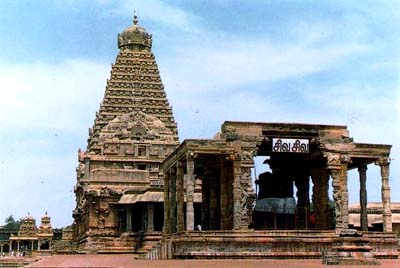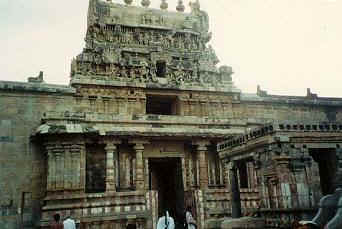Apr 15, 2024
Apr 15, 2024
In the 10th and 11th centuries, the south too witnessed the construction of massive temples, great cathedrals in their own right. With the passage of time, the Chola dynasty came to dominate politics in south India. With their progression to power, the small scale of the Pallava masterpieces - the rathas and the Shore temple at Mahabalipuram - was not sufficient as a showpiece of Chola power. The craftsmen were soon to be put to a greater test.
The Great Temple at Thanjavur
 Today Thanjavur or Tanjore is an ordinary little town in Tamil Nadu. However, as the capital city of the Cholas, nothing surpassed it in wealth and power in the 11th century. In 1000 A.D. the Chola king Rajarajeshwara the Great commissioned a temple, which was revolutionary by its sheer size, dwarfing all efforts made so far in the south. So the Rajaraja temple at Tanjore was 180 feet high from the ground, with a spire of 130 feet, fully 70 feet higher than the tallest spire so far attempted. This soaring height was capped by an enormous domical monolith, weighing at least 80 tons.
Today Thanjavur or Tanjore is an ordinary little town in Tamil Nadu. However, as the capital city of the Cholas, nothing surpassed it in wealth and power in the 11th century. In 1000 A.D. the Chola king Rajarajeshwara the Great commissioned a temple, which was revolutionary by its sheer size, dwarfing all efforts made so far in the south. So the Rajaraja temple at Tanjore was 180 feet high from the ground, with a spire of 130 feet, fully 70 feet higher than the tallest spire so far attempted. This soaring height was capped by an enormous domical monolith, weighing at least 80 tons.
In this temple, which is arranged as always around a central axis, the two mandapas in front of the Vimana are also proportionately bigger. The entire complex of the main temple and its ancillary structures and subsidiary shrines is in the middle of a rectangular, defined by a portico with a double colonnade. The Vimana, though not much shorter than the projected spire at Konark, is structurally intact even after a thousand years. In this respect, the Tamil architects proved themselves far more adept than their northern peers. This was to be seen again in a later example. It was also true, of course, that the form chosen was far more prudent, a comparatively stable pyramid rather than the complex curvilinear profile of the shikhara.
The Temple at Gangaikondacholapuram
 Growing chola power in the south was accompanied by a corresponding increase in patronage for the arts, the building of new cities and improvement in material life of the city-states as a whole. Rajendra I, the successor to Rajaraja the Great, in a bid to assert his own kingly identity, took the bold step of shifting his capital from Tanjore to Gangaikondacholapuram. As was common, the city needed to be built around its own mighty cathedral, the seat of all spiritual power.
Growing chola power in the south was accompanied by a corresponding increase in patronage for the arts, the building of new cities and improvement in material life of the city-states as a whole. Rajendra I, the successor to Rajaraja the Great, in a bid to assert his own kingly identity, took the bold step of shifting his capital from Tanjore to Gangaikondacholapuram. As was common, the city needed to be built around its own mighty cathedral, the seat of all spiritual power.
Today the town is in ruins, and the temple scarcely less so. Yet the temple at Gangaikondacholapuram was important because of innovations that affected South Indian temple architecture in the future. The main Vimana on a base even larger than the temple at Tanjore, rises up in a concave curve, which is in total contrast to "the rigid and geometrically perfect Vimana of Tanjore, that symbolizes conscious might…" while in the example at Gangaikondacholapuram "…the fluid lines…are imbued with a subconscious grace".
The second innovation is the Mandapa. The huge flat-roofed hall has processional aisles that remain at ground level. To hold up such a large area of roof, a veritable forest of columns supports the mandapa. This approach is the forerunner of the famous 'halls of thousand columns' of later efforts in temple building.
The Decline of the Cholas - the Pandyas Come to Power
After the death of Rajendra I in 1050 A.D., the power of the Cholas slowly waned from incessant disputes with the other powers of the south - the Chalukyas, Pandyas and Kerala. Eventually the Chola Empire was usurped by the Pandya dynasty, which inherited all of its considerable wealth and trade agreements with foreign powers. By this time, i.e. the 14th Century A.D., considerable political changes were taking place. The most threatening was evidence of a new, irresistible force from the north - the all-conquering hordes of Islam.
This threat made the Pandya rulers hurriedly throw up makeshift battlements around their cities and the heart of their towns -the temples. Thus an ancient, venerated shrine could often find itself in the position of being reduced in appearance to a fortress, that too a most utilitarian one.
For so religious a people, this was unacceptable. To change the outer covering, i.e. the form of the temple itself would be nothing short of sacrilege. The Pandya rulers hit upon a novel solution: raise the gates of the fortress to the level of architecture. This was the genesis of the famous gopurams, or entrance gateways of the temple cities of the south.
These temple cities and their sociological implications will be the subject of our next chapter in this story of Indian architecture.
26-Apr-2001
More by : Ashish Nangia

|
Great article, but I believe there is a typo. You typed Kerala but probably meant the Cheras. |

|
Sorry sir she is my biggest sister |